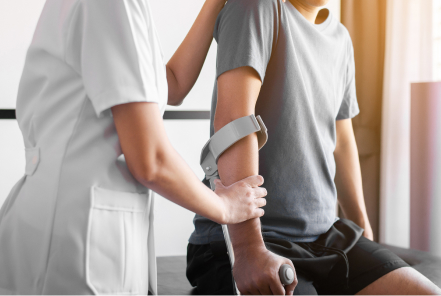Rehab
Rehab
Following ACL reconstruction, to make the swiftest, safest gains, the following programme is recommended. On occasion this will vary and is only suggested as a broad framework. Throughout the process the therapists and surgeon may make other suggestions.
Advantages of early mobilisation include the prevention of stiffness and nutrition to the cartilage. Using the graft stimulates healing but exercises must remain closed chain in order to protect against the sliding displacement of the tibia.
A knee brace is often not used.


Hip arthroscopy rehab
Your operation can take from 1.5 to 3 hours, depending on how much work needs to be performed. You may need to stay in hospital overnight following your procedure. In some cases you may be able to go home on the same day (dependent on the extent of your surgery, and the time the procedure is completed). This may vary depending on your medical history and also on how you are managing to mobilise with help from the physiotherapists
Excercises
Stage 1
Initial phase (Week 1-3)
Improving range of movement
Aims:
- Reduce pain and swelling.
- Normalise your walking pattern depending on weight bearing status.
- Improve hip muscle strength and core strength.
- Improve movement at your hip, including rotation.
- Improve your balance.
** Avoid active hip flexion as the Psoas tendon settles down after the surgery.**
Stage 2
Intermediate phase (Week 3-5)
Aims:
Improve muscle strength by functional exercise – Step ups/down, static bike etc.
Improve core strength (the muscles in your abdomen, back, pelvic floor and hips).
Improve balance – double leg to single leg.
Maintain cardiovascular fitness – Swimming – no breast stroke, static bike, walking on treadmill (if walking pattern normalised).
Improve movement.
Complete hydrotherapy; if appropriate.
Week 6 – Consultant review and completion of HOOS/ functional questionnaires (electronically).
Stage 3
Advanced phase (Week 5 -12)
Aims:
Improve muscle endurance.
Full hip range of movement with stable pelvis.
Good core control and stability (have strong and flexible muscles in your core).
Improve cardiovascular fitness.
Begin plyometric work – fast, change of direction exercises useful for sport.
Week 12 – Consultant review and completion of HOOS/ functional questionnaires (electronically).
Stage 4
Sports specific rehab (Week 12+)
Aims:
Designed for people who want to return to competitive sport.
Gradually return to maximal effort
Challenge balance.
Complete full impact activities.
Begin sport training before returning to full competition.
Eliminate asymmetries in activities such as running.
Goals
Post operative progress:
As listed above you will be reviewed at regular intervals by a physiotherapist, who will assess your progress. The most important component of your recovery is your regular attendance at physiotherapy classes where you will be given strict instructions regarding appropriate exercises and the ‘dos and don’ts’.
At certain points before and after your surgery we will be going through one or two questionnaires with you to provide us with information about your functional improvement. The reason for this is not only to make sure you are getting better; but also to assess that surgery has been successful for my own records. Your co-operation in this will be much appreciated.

